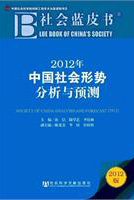Abstract: This is the 2012 Annual Report (the Blue Book of China’s Society) from the Research Group on “The Analysis and Forecast of China’s Social Development”, issued by Chinese Academy of Social Sciences (CASS). Researchers and scholars from various research institutions, universities and government departments report on statistical data released by the government or social science surveys. This project is organized by the Institute of Sociology at ChineseAcademy of Social Sciences.
The report notes that, in 2011, under the background of complex and volatile international situation, coupled with emerging social problems at the domestic level, China has made great effort to stimulate transformation of economic structure. Under the banner of scientific development, government focuses on improving and safeguarding people’s well-being. At the same time, income level for both urban and rural residents continues to rise, as well as the scale of domestic consumption. Meanwhile, the prices on basic household necessities have been stabilized, inflation rate is kept under control, the employment situation has improved dramatically, and the establishment of social security system in rural areas has stepped into a new stage. In 2011, China’s urban population outnumbers rural population for the first time throughout China’s history, which announces that China, traditionally known as an agriculturalsociety with thousands of years of civilization, has crossed the threshold of urbanization and reached a new phase of development. The rising percentage of urban residents should not be interpreted as a simple statistical change. Instead, behind the number, it represents a substantial transformation of the mode of production, occupation distribution, people’s consuming behavior, their life-style, and values and worldview. After the phase of industrialization, urbanization becomes the new engine for China’s economic growth.
The report also emphasizes that soaring prices on basic household goods have already affected the living standard of the low income population. Also, it is critical to contain inflation rate, and establish a new mechanism to narrow the gap of income level between urban and rural residents. The employment situation becomes more complicated in the year of 2011. Due to significant structural deficiency of the current labor market, China encounters the dilemma that, on the one hand, it is difficult for the newly graduated students to find a job; while on the other hand, there is a “recruitment crisis” at the primary labor market. Meanwhile, it is often not easy for the surplus labor force in rural areas to transfer to other regions. Therefore, it is important to maintain policy consistency and put job-creation as our top priority. Since July 1st 2011, the Social Insurance Law comes into effect. In the following months, we have witnessed an increasing amount of labor dispute cases, which requires us to step up efforts to stipulate supplemental policies and measures. The whole society still pays extensive attention on the issue of income distribution. Although the income disparities among regions and between urban and rural areas are narrowed, the general trend of widening income gap is not reversed. As a result, we should push for an income distribution mechanism which is fair and reasonable, and maintain the adjustment of income distribution as our top policy agenda. Furthermore, government should also strengthen its regulation on environment pollution incidents, prevent production safety related accidents, and promote a society of trust with a better credit system.
In 2012, the Eighteenth National Congress of the Communist Party of China will be held in Beijing, which will set the main theme for China’s future development. China will move into a brand-new stage of development.

